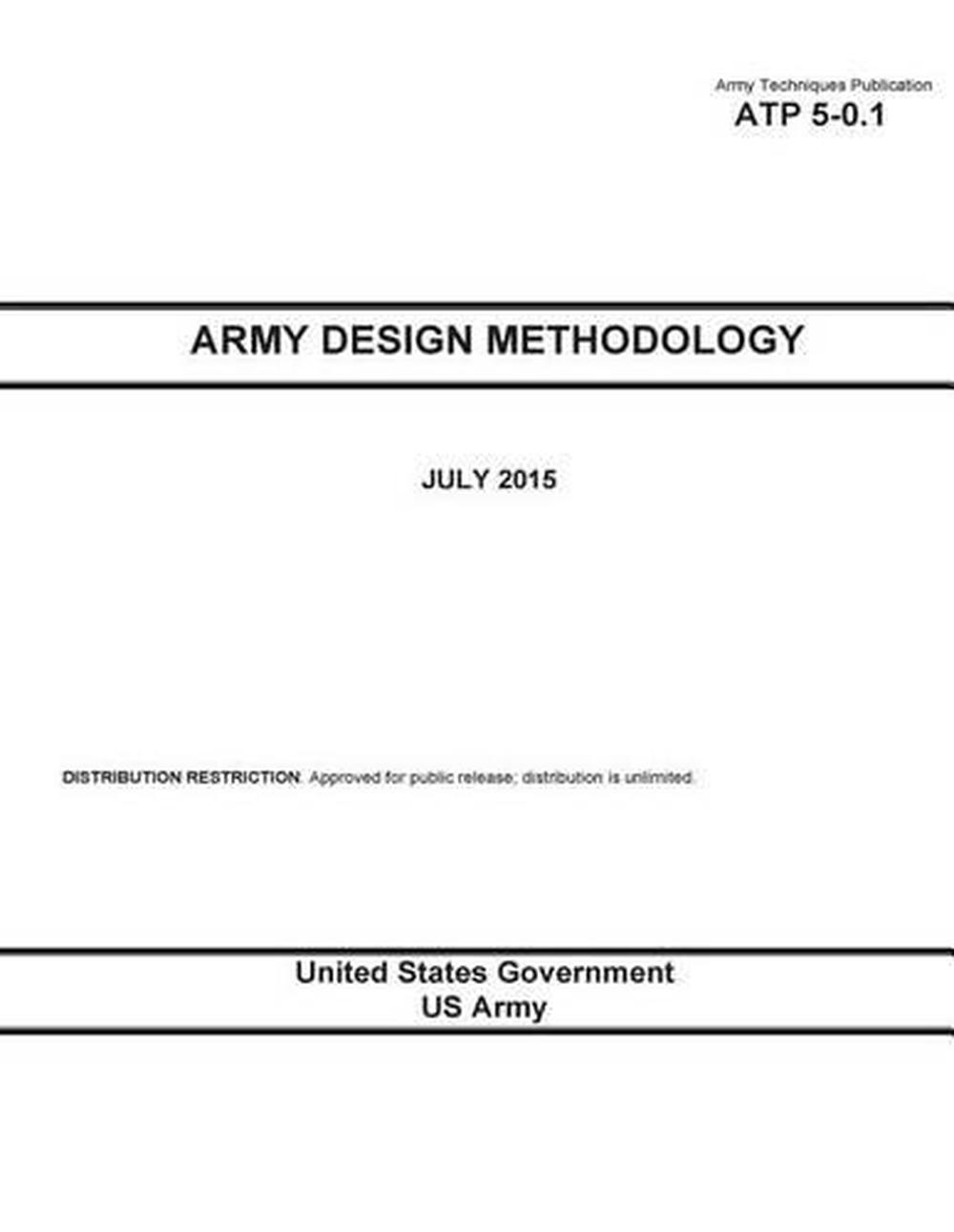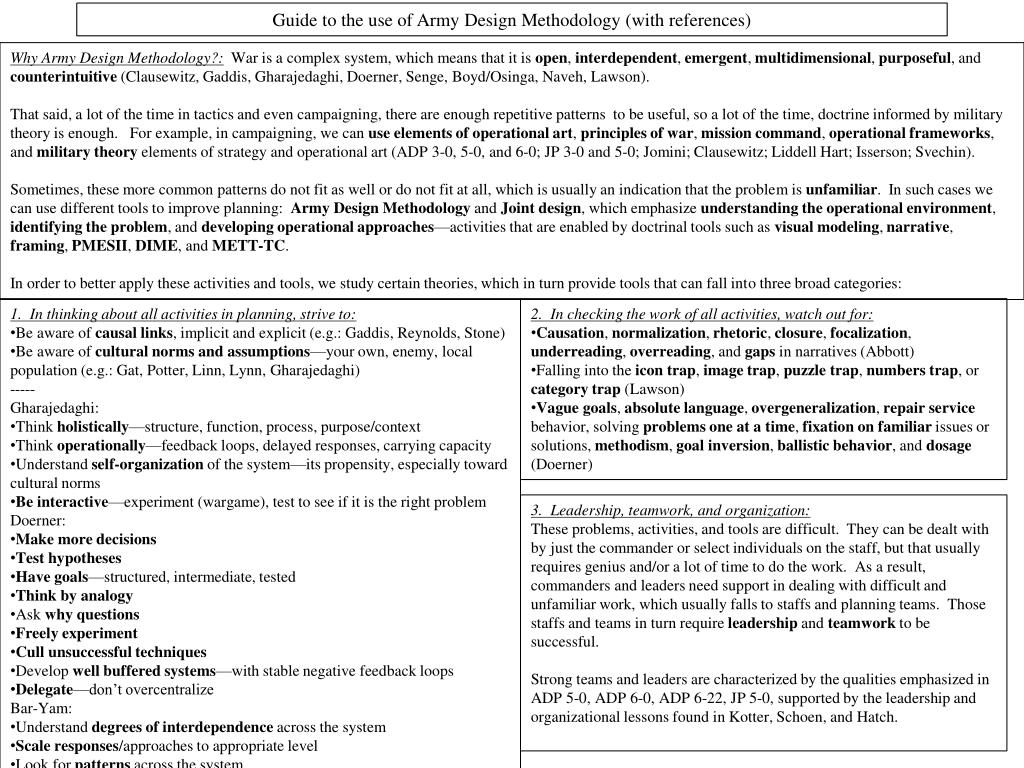Table Of Content

Small Wars Journal is published by Small Wars Foundation - a 501(c)(3) non-profit corporation.

The Army Design Methodology: Enhancing Decision-Making in a Complex World
LTC Moore did not anticipate the enemy’s aggressiveness, although he successfully employed operational art by identifying and using appropriate resources and prevented the loss of his entire battalion. LTC Moore did little to understand how the OE may trend or the future state of other actors, although all echelons of command clearly articulated the end state. Identifying and defining the tools and techniques ensure that staff members can execute the ADM process while CSMs can incorporate the concepts into professional development lines of effort.
Army Design Methodology: Framing the Operational Environment
He currently attends the Sergeants Major Course at the US Army Noncommissioned Officer Leadership Center of Excellence. He holds a bachelor’s degree in Commerce major in Business Administration from the University of Santo Tomas. He is currently pursuing a Master of Science in Management majoring in Organizational Leadership.
What Will the Future of Human-Robot Teams Actually Look Like? - Modern War Institute - United States Military Academy West Point
What Will the Future of Human-Robot Teams Actually Look Like? - Modern War Institute.
Posted: Mon, 27 Apr 2020 07:00:00 GMT [source]
Framing Solutions in Army Design Methodology
In the last ten years, the topic of design was a source of conflict between many military leaders who believed it was already inherent in the military decision-making process. Design, however, should be considered less as a process, and more as a way of thinking about complexity. While design doesn’t eliminate all error, it is a proven tool used by many disciplines to develop creative ways to approach complex situations that can enhance the detailed planning offered by the Military Decision Making Process (MDMP). This paper will first explain the key concepts of the Army Design Methodology (ADM) and how they relate to MDMP.
Army Design Methodology: Operational Art in Combat
The Americans also predicted that the NVA would be successful without intervention and that Vietnam would be a communist state. Master Sergeant (MSG) Dimas A. Fonseca Jr. is an active duty Soldier, serving in the United States Army since July 3rd, 2001. He is originally from La Habra, California and has a Master's degree in Organizational Leadership from Columbia Southern University. Since enlisting, he's had the honor of serving all over the world, to include two deployments to Afghanistan. His awards and decorations include the Bronze Star Medal and Meritorious Service Medal to name a few. MSG Fonseca is currently attending the Sergeants Major Academy at Fort Bliss, Texas as a student of Class 73.
Using the Army Design Methodology Process to Frame Problems
How the British Army's operations went agile - McKinsey
How the British Army's operations went agile.
Posted: Thu, 31 Oct 2019 07:00:00 GMT [source]
MAJ Raymond M. Longabaugh is currently serving as the Train Advise Assist Command-East G4 in Afghanistan. He previously served as a sustainment planner in the G5 of the 3rd Infantry Division at Fort Stewart, Ga. He holds a bachelor’s degree in history from Millsaps College, a master’s degree in public administration from North Carolina State University, and a master’s in military art and sciences from the U.S. During his career, MAJ Longabaugh served with the 101st Sustainment Brigade, the 82nd Airborne Division, the Defense Logistics Agency, and 3rd Army Headquarters. Master Sergeant Rodani Tan is a Senior Finance Manager who deployed multiple times in support of Operation Enduring Freedom.
Army Design Methodology: Operational Art in Combat
Collaboration and dialogue between CDRs and staff create an important learning environment in which members can think critically and creatively with a candid and open exchange of ideas. “Collaboration and dialogue help develop shared understanding between the CDR and staff and externally with other CDRs and unified action partners” (DA, 2015, p. 1-7). For instance, collaboration and dialogue usually happen in working group meetings where participants exchange opinions and encourage competition of ideas. Both enhance understanding, improve group thinking, and eventually produce a better solution to solve a problem. The knowledge developed in working groups produces a frame of reference for developing solutions that help build a visual model and narrative.
Army Design Methodology: Framing the Operational Environment
Within the ADM process, commanders and staff members apply the use of operational art to all significant activities, including framing problems. Operational art is the cognitive approach to developing strategies, campaigns, and operations which defines the purpose of military force at all levels of war (Joint Chiefs of Staff, 2022). Operational art also has elements that support the concept, such as identifying centers of gravity, establishing decisive points, and creating lines of operation and effort. Under contingency operations, leaders can leverage operational art to determine the required military force to provide security along a main supply route.
During a brainstorming session, questioning assumptions by the planning team further integrates ADM tools and techniques. As Soldiers assigned to the SGM-A learned during practical exercises, understanding framing the problem within the ADM process will lead to appropriate facilitation in organizations. T he current strategic operating environment in which US military forces operate has changed significantly in the past 20 years. The US military has shifted its strategy from a reactive, conventional-planning focus to one that encompasses a proactive, shaping strategy that focuses on a broad array of threats. Inherent within this shaping strategy is the requirement to set environmental conditions that directly or indirectly support US goals and objectives. To develop and execute a successful strategy, an in-depth understanding of the social make-up of the environment, to include the cultural, historical, religious, economic, and political aspects of that social framework, is necessary.
Narrative construction uses words to give meaning to individuals, things, and events (DA, 2015). The purpose of a narrative is to tell a story and improve understanding of a visual model. For instance, creating a paragraph helps define a visual model to provoke thinking and learning, which helps reveal meaning in the facts presented for analysis. Narrative and visual modeling are essential in creating framing solutions to improve the activities involved in developing an operational approach.
Elements like the center of gravity (COG) and decisive points are essential in creating an operational approach within the limits of resources and capabilities and an important activity within framing solutions. JCS (2020) defines COG as “the source of power or strength that enables a force to achieve its goals or where an opposing force can focus its operation, which will lead to enemy failure” (p. IV-22). A COG is a critical capability with critical requirements and vulnerabilities that form a system. An example of a COG is a mechanized unit, which can disrupt ground forces but requires logistics to enable projection and becomes vulnerable when prevented from receiving a resupply of fuel and ammunition.
As the United States continues to provide equipment and resources, the operational approach of Ukraine will aid in achieving its desired results. As they continue to refine their operational approach, it is critical to document the results for better planning in the future. However, leaders must question assumptions as a risk-mitigating measure to help avoid poorly stating a problem. If the planning team does not validate assumptions when framing the problem, false assumptions will eventually become a risk to the operation (Joint Chiefs of Staff, 2020). Returning to the example of protecting a supply route, questioning the assumption that an enemy force will attack the supply route will help the planning team determine the military force required for the security mission. Staff members on the planning team that questioned assumed obstacles would lead to properly framing the problem.
The scenario demonstrates that the overall risk of an operation is significantly higher with too much commander involvement (Department of the Army, 2015). Documenting the results of ADM activities enables the transfer of knowledge and understanding to other CDRs, staff, and unified action partners (DA, 2015). The documented results from ADM also provide knowledge and information for further detailed planning. Documenting the results also provides lessons that a SGM can use to improve their organization. Critical requirements or vulnerabilities can represent decisive points during battle to diminish an enemy’s capability.

No comments:
Post a Comment